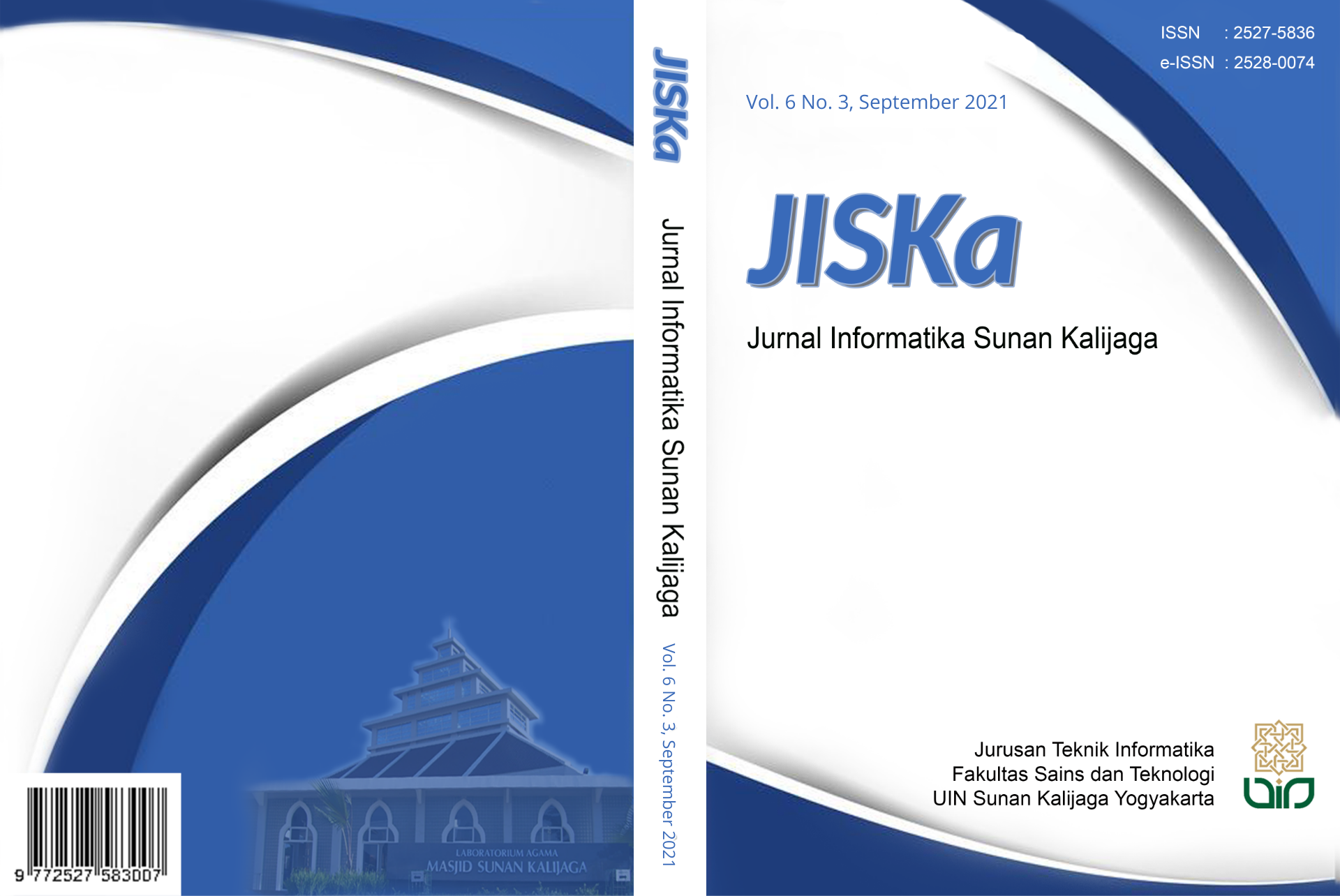Implementasi Algoritma RC4 pada Sistem Pengamanan Dokumen Digital Soal Ujian
DOI:
https://doi.org/10.14421/jiska.2021.6.3.171-177Keywords:
Digital Data, Cryptography, RC4 Algorithm, Waterfall, WebsiteAbstract
The development of science and technology has led to changes in the use of documents in life to become digital data. However, this can cause problems, namely regarding data security and confidentiality. To increase security and confidentiality can be done with cryptographic algorithm RC4. The research method uses the Waterfall method. The result of this research is a website that can secure document files with * doc extension using the RC4 algorithm. The test was carried out using the blackbox test and the CrackStation test for encryption testing. The results of the test show that the website can run well and successfully implements the RC4 algorithm.
References
Agung, H., & Budiman, B. (2015). IMPLEMENTASI AFFINE CHIPER DAN RC4 PADA ENKRIPSI FILE TUNGGAL. Prosiding SNATIF, 0(0), 243–250.
Alneyadi, S., Sithirasenan, E., & Muthukkumarasamy, V. (2016). A survey on data leakage prevention systems. Journal of Network and Computer Applications, 62(C), 137–152. https://doi.org/10.1016/j.jnca.2016.01.008
DataLossDB. (2016, February 11). 2015 Reported Data Breaches Surpasses All Previous Years. https://datalossdbdotorg.wordpress.com/
Hakim, E. L., Khairil, K., & Utami, F. H. (2014). APLIKASI ENKRIPSI DAN DESKRIPSI DATA MENGGUNAKAN ALGORITMA RC4 DENGAN MENGGUNAKAN BAHASA PEMROGRAMAN PHP. JURNAL MEDIA INFOTAMA, 10(1), 1–7. https://doi.org/10.37676/JMI.V10I1.226
Menezes, A. J., van Oorschot, P. C., & Vanstone, S. a. (2001). Handbook of Applied Cryptography. In Handbook of Applied Cryptography (Issue 9). CRC Press.
Nugroho, N. B., Azmi, Z., & Arif, S. N. (2016). APLIKASI KEAMANAN EMAIL MENGGUNAKAN ALGORITMA RC4. Jurnal SAINTIKOM, 15(3), 81–88.
Pressman, R. S. (2003). Rekayasa Perangkat Lunak Pendekatan Praktisi (Buku II). Andi.
Purba, B., Gulo, F. A., Utami, N. I., & Sihotang, Y. A. (2020). Pengamanan File Teks Menggunakan Algoritma RC4. Seminar Nasional Teknologi Komputer & Sains (SAINTEKS), 420–425.
Ridho, M., & Jemakmun. (2020). IMPLEMENTASI KEAMANAN BASI DATA PADA DATA PEGAWAI DI PT TIRTA MUSI MENGGUNAKAN METODE RC4. Universitas Bina Darma.
Saragi, D. R., Gultom, J. M., Tampubolon, J. A., & Gunawan, I. (2020). Pengamanan Data File Teks (Word) Menggunakan Algoritma RC4. Jurnal Sistem Komputer Dan Informatika (JSON), 1(2), 114–119. https://doi.org/10.30865/json.v1i2.1745
Subhan, S., Amini, S., & Ariyani, P. F. (2017). IMPLEMENTASI PENGAMANAN DATA ENKRIPSI SMS DENGAN ALGORITMA RC4 BERBASIS ANDROID. Prosiding SENIATI, A29.6.
Sumarno, S. (2018). Analisis Kinerja Kombinasi Algoritma Message-Digest Algortihm 5 (MD5), Rivest Shamir Adleman (RSA ) dan Rivest Cipher 4 (RC4) Pada Keamanan E-Dokumen. Jurnal Sistem Informasi Dan Ilmu Komputer Prima (JUSIKOM PRIMA), 2(1), 41–48.
Waluyo, S., & Kanahebi, D. V. (2021). Sistem Pengamanan File Menggunakan Algoritma Rc4 Berbasis Webbase Studi Kasus : Pt. Tjipta Jaya Bersama. Semnas Ristek (Seminar Nasional Riset Dan Inovasi Teknologi), 5(1), 803–808.
Widiyanto, W. W. (2018). ANALISA METODOLOGI PENGEMBANGAN SISTEM DENGAN PERBANDINGAN MODEL PERANGKAT LUNAK SISTEM INFORMASI KEPEGAWAIAN MENGGUNAKAN WATERFALL DEVELOPMENT MODEL, MODEL PROTOTYPE, DAN MODEL RAPID APPLICATION DEVELOPMENT (RAD). Jurnal Informa : Jurnal Penelitian Dan Pengabdian Masyarakat, 4(1), 34–40. https://doi.org/10.46808/INFORMA.V4I1.34
Zebua, T., & Ndruru, E. (2017). Pengamanan Citra Digital Berdasarkan Modifikasi Algoritma RC4. Jurnal Teknologi Informasi Dan Ilmu Komputer, 4(4), 275–282. https://doi.org/10.25126/jtiik.201744474
Downloads
Published
How to Cite
Issue
Section
License
Copyright (c) 2021 Fauziyah Suwarsita Febriyani, Arief Arfriandi

This work is licensed under a Creative Commons Attribution-NonCommercial 4.0 International License.
Authors who publish with this journal agree to the following terms as stated in http://creativecommons.org/licenses/by-nc/4.0
a. Authors retain copyright and grant the journal right of first publication with the work simultaneously licensed under a Creative Commons Attribution License that allows others to share the work with an acknowledgement of the work's authorship and initial publication in this journal.
b. Authors are able to enter into separate, additional contractual arrangements for the non-exclusive distribution of the journal's published version of the work (e.g., post it to an institutional repository or publish it in a book), with an acknowledgement of its initial publication in this journal.
c. Authors are permitted and encouraged to post their work online (e.g., in institutional repositories or on their website) prior to and during the submission process, as it can lead to productive exchanges, as well as earlier and greater citation of published work.










